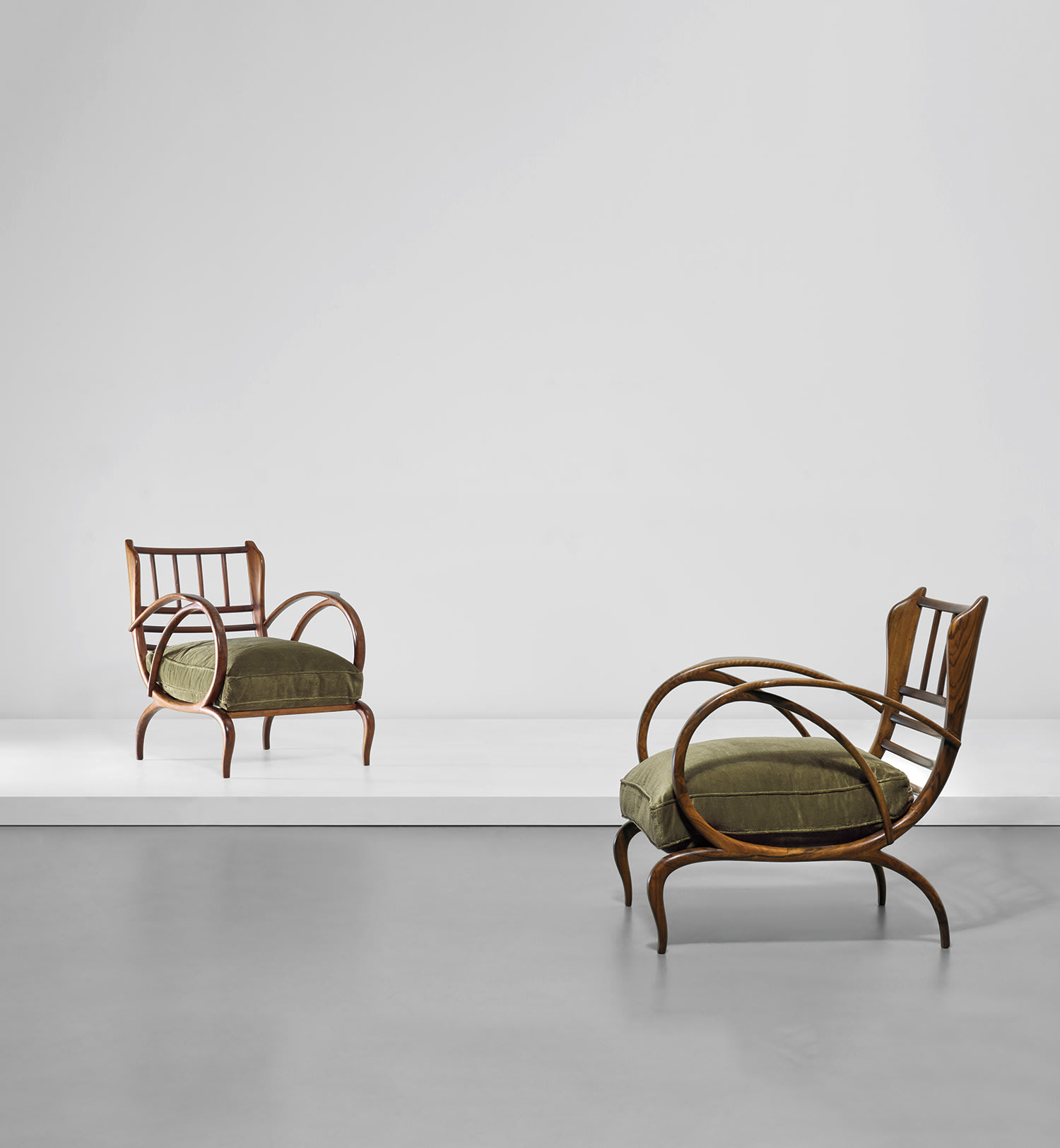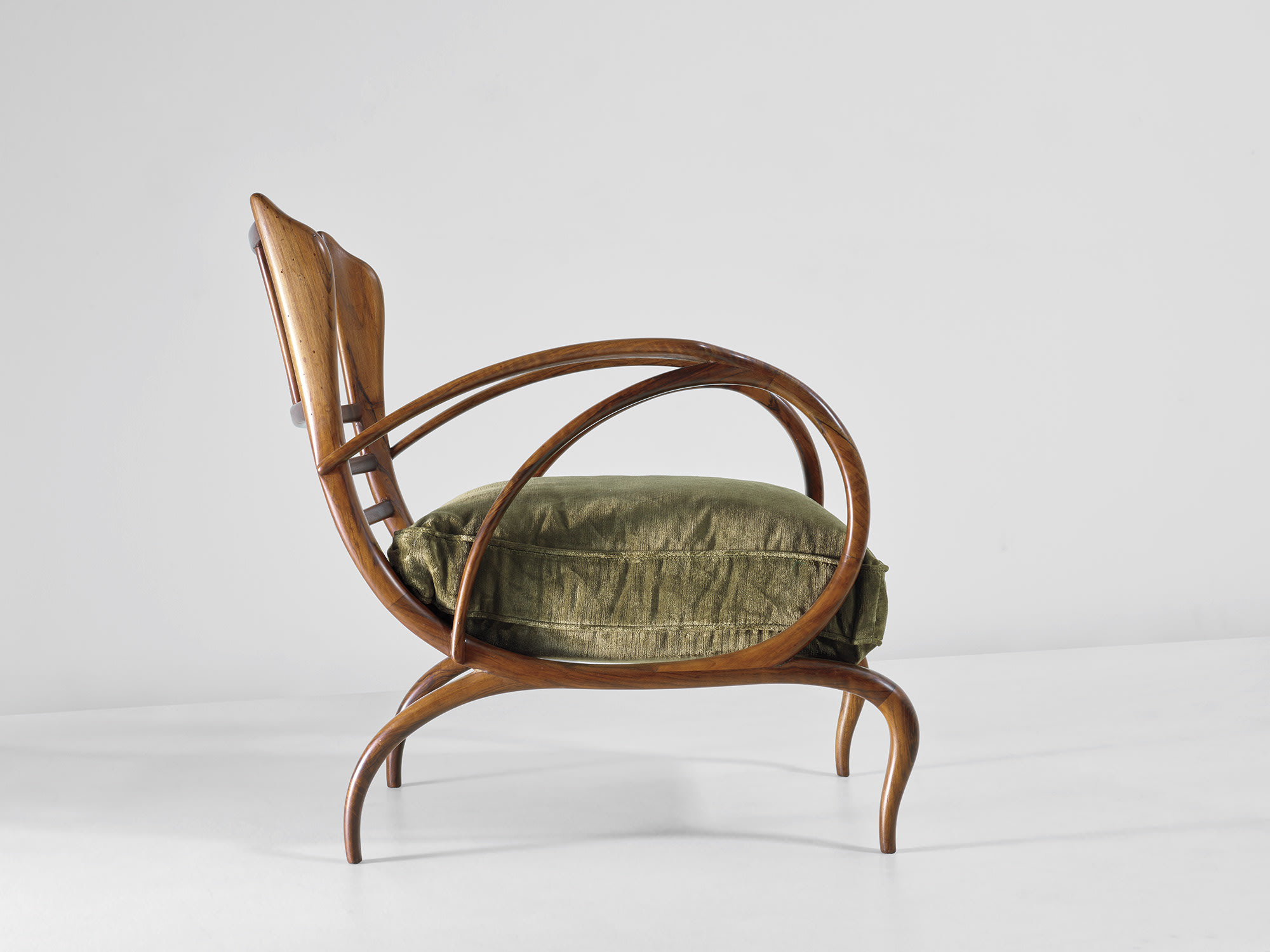







6
Gio Ponti
Unique pair of armchairs
Full-Cataloguing
By Brian Kish
Curator and Specialist in 20th Century Italian architecture and design. Associate member of the Gio Ponti Archives since 2006.
After his success at creating ceramic masterpieces ceramic at Richard Ginori in 1923, Gio Ponti confidently turned his attention to other aspects of the decorative arts, and it is within the field of furniture design that he spent more time than any other except of course for his persistent output in architecture. Commencing in 1928 with his Domus Nova collection for the Rinascente department stores, he immediately hit a stride of very elemental designs that were a hybrid of Novecento and Rationalist idioms, which were then two clearly opposing trends in Italian architecture in the mid 1920s and 30s.
By 1930 Ponti was receiving high-profile commissions for custom furniture, such as that for the refurbishment of Count Contini-Bonacossi’s palazzo in Florence. Around the same time, he was asked to work on a smaller project for another noble family from Lombardy, his native region. It is the set of one coffee table and two chairs that we are introducing here; and it is with this suite that Ponti began developing a range of expressive forms, that settled the direction of all his subsequent design endeavours.
As we cast our first glance on these objects, we sense the influences of Vienna and the late Wiener Werkstätte, which had incorporated distillations of Biedermeier forms. In the early issues of Domus magazine from 1928 on, Ponti enthusiastically reported on the latest in Viennese output. Meanwhile he was also personally acquainted with Adolf Loos, Josef Frank, Oskar Wlach, and Oswald Haerdtl way before his 1936 interior designs for the Palais Fürstenberg in Vienna.
With his facility for invention Ponti set out to harness Viennese traits towards a more Italianate idiom, which involved dialing back to ancient Roman motifs and lunging forward to Italian Futurism. The former is fully expressed in the double tiered coffee table, with a carved wooden rosette at its centre. This motif is embedded in an intricate web of woven cane that stands out through intense, nearly kaleidoscopic optics. For Ponti this schematic image is but a fleeting memory of ancient Roman floor mosaics.
This top tier roundel is stretched under a glass top allowing a sightline to the lower tier, which has precisely book-matched walnut veneers. The two circular table surfaces appear suspended from their four looped supports that are in turn conjoined to a ringed base. This sculptural exuberance is in perfect synergy with the armchairs.
With them, Ponti suddenly speeds forward close to his own time as he introduces an echo of Umberto Boccioni’s 1913 sculpture ‘Forme uniche della continuità nello spazio’ (Unique Forms of Continuity in Space) into his new commission. By anthropomorphising a basic chair scheme and merging it with the Futurists’ human form in motion, Ponti achieves a graceful new typology, which is obvious with even a cursory glance at the legs.
Essentially based on the European Bergère model, its wings seem lifted by a delicate line that accelerates as it loops and ends into a split arm rest. Such elaborate interpretations of patrician forms were intended to set off his forward-looking interiors, thus initiating a dialogue between the past and present. On the basis of this early 1930s model, Ponti produced numerous reiterations to be found in every decade. The closest example could be the armchairs he designed for the Palazzo Bo (1938/40). This eventually led to a tectonically enhanced version for the 1951 ‘Triennale’ chair before reaching its apex and conclusion with the 1960s abstracted wing-backs in the lobbies of both Parco dei Principi hotels.
Just as the furniture for Count Contini Bonacossi, this early 1930s suite is labeled with small brass plaques with Ponti’s signature. It was undoubtedly executed by Angelo Magnoni, senior ebanista at Quarti, Milan's most prestigious furniture company. The quality of the walnut timbers chosen and carving point to the full trust Ponti had in Magnoni’s work as he remarked in Amate l Architettura: ‘Many people love wood; Among those I know is the old Magnoni; he used to say, 'Leave it to me’’ (Gio Ponti, Amate l Architettura, Genoa, 1957, p. 135).
Gio Ponti
Italian | B. 1891 D. 1979Among the most prolific talents to grace twentieth-century design, Gio Ponti defied categorization. Though trained as an architect, he made major contributions to the decorative arts, designing in such disparate materials as ceramics, glass, wood and metal. A gale force of interdisciplinary creativity, Ponti embraced new materials like plastic and aluminum but employed traditional materials such as marble and wood in original, unconventional ways.
In the industrial realm, he designed buildings, cars, machinery and appliances — notably, the La Cornuta espresso machine for La Pavoni — and founded the ADI (Industrial Designer Association). Among the most special works by Gio Ponti are those that he made in collaboration with master craftsmen such as the cabinetmaker Giordano Chiesa, the illustrator Piero Fornasetti and the enamellist Paolo de Poli.